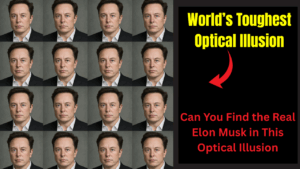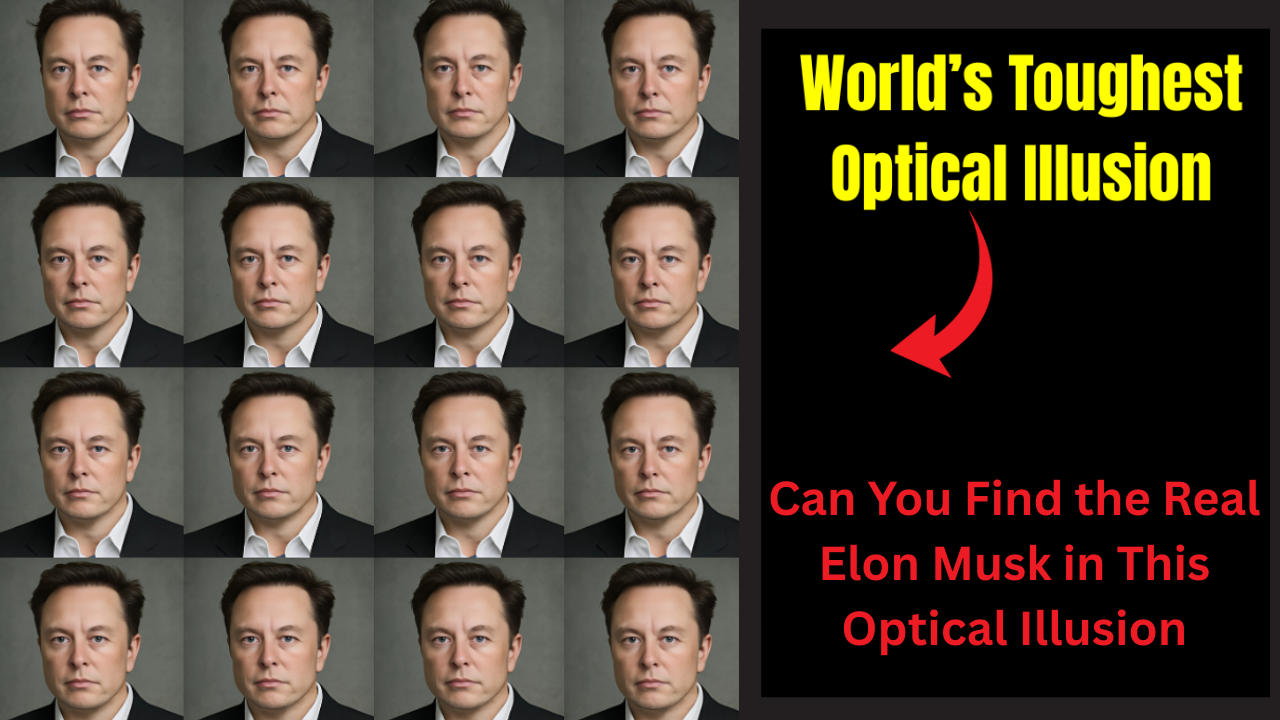Optical illusions have a unique way of captivating our minds, challenging our perceptions, and leaving us questioning what we see. When these illusions feature well-known figures like Elon Musk, the intrigue deepens. The billionaire entrepreneur, known for leading Tesla, SpaceX, and X, has become a cultural icon whose image is instantly recognizable—or so we think. In recent years, optical illusions featuring Elon Musk have gone viral, baffling viewers and even stumping the man himself. These visual puzzles, often shared on platforms like X, play with our brains in fascinating ways. In this article, we’ll explore a specific Elon Musk optical illusion, delve into the science behind it, and challenge you to find the “real” Elon Musk within the trickery. Can you crack the puzzle?

The Viral Elon Musk Optical Illusion
One of the most talked-about optical illusions involving Elon Musk is an image that appears to be a simple, upside-down photograph of the entrepreneur. At first glance, it looks like a typical flipped picture, perhaps taken during one of his high-profile events or candid moments. However, a closer inspection reveals something unsettling: the facial features don’t quite align as expected. When you rotate the image 180 degrees to view it right-side up, the true trickery emerges—a distorted, almost nightmarish version of Musk’s face stares back. This illusion, created by The Sun in 2022, leverages a psychological phenomenon known as the Thatcher Effect to deceive the brain.
The Thatcher Effect, first demonstrated in 1980 with an image of former UK Prime Minister Margaret Thatcher, exploits how our brains process faces. When a face is inverted, we struggle to notice subtle changes in the configuration of features, such as eyes or mouths being flipped. In the Musk illusion, his eyes and mouth are oriented correctly in the upside-down image, blending seamlessly with the inverted face. But when the image is flipped right-side up, these correctly oriented features clash with the rest of the face, creating a jarring, unnatural appearance. This clever manipulation highlights how easily our visual perception can be fooled.
Another Musk-related illusion that gained traction involves a grid of letters, predominantly Ns, with a few Ms hidden among them. Shared by Musk on his official X account in 2024, this puzzle challenges viewers to spot the Ms within 10 seconds, testing observational skills and cognitive speed. The caption read, “How many (M) do you see? Perfect eyes and IQ will see it.” Users on X eagerly shared their counts, with answers ranging from 8 to 10, including Ms in the title or caption. This illusion, while simpler than the Thatcher Effect image, showcases how our brains can overlook details in a sea of similarity.
A third illusion, which stumped even Musk himself, features two cubes that appear to rotate in opposite directions against a flashing background. Posted by X user Steve Stewart-Williams in 2020 and resurfacing in 2022, the image elicited a succinct “Wow” from Musk. The twist? The cubes are static, and the perceived motion is due to the phi phenomenon, where flashing lights create the illusion of movement. This puzzle underscores the power of visual cues to trick our brains into seeing what isn’t there.
The Science Behind Optical Illusions
To understand why these Musk illusions are so effective, we need to explore the science of visual perception. Our brains are wired to make sense of the world quickly, often filling in gaps or making assumptions based on incomplete data. This efficiency, while useful, makes us susceptible to optical illusions, which exploit these cognitive shortcuts.
The Thatcher Effect, as seen in the upside-down Musk image, relies on our brain’s specialized face-processing system. Humans are exceptionally skilled at recognizing faces, thanks to a region in the brain called the fusiform gyrus. However, this system is optimized for upright faces. When a face is inverted, the brain struggles to process the spatial relationships between features, causing us to miss distortions. Only when the image is rotated do we notice the anomalies, as our face-recognition system kicks into high gear. This explains why the Musk illusion seems normal when upside-down but terrifying when right-side up.
The phi phenomenon, used in the rotating cubes illusion, taps into our perception of motion. When two nearby objects are alternately illuminated, our brains interpret this as a single object moving between the two positions. In the cube illusion, the flashing background and cycling shadows around the cubes’ edges create a false sense of rotation. This phenomenon is commonly used in animations and theater marquees to simulate motion, demonstrating how our brains prioritize continuity over accuracy.
The letter-grid illusion with Ns and Ms engages our attention and pattern-recognition abilities. Our brains are adept at identifying patterns, but when presented with a dense field of similar shapes, they can overlook subtle differences. This illusion tests our selective attention, similar to the famous “count the Fs” puzzle, where readers often miss Fs in words like “of.” By hiding Ms among Ns, the puzzle forces us to slow down and scrutinize each element, revealing how easily we can miss details in familiar contexts.
Why Elon Musk?
Why has Elon Musk become a focal point for these optical illusions? As a polarizing and omnipresent figure in media, Musk’s image is both highly recognizable and ripe for creative manipulation. His status as a tech visionary, coupled with his active presence on X, makes him a natural target for viral content. When Musk himself engages with these illusions, as he did with the cubes and letter grid, it amplifies their reach, drawing millions of viewers into the puzzle.
Moreover, Musk’s persona—part innovator, part provocateur—lends itself to the surreal nature of optical illusions. Just as his tweets can spark debates or shift markets, these illusions challenge our perceptions and invite scrutiny. The distorted Musk face, for instance, mirrors the public’s complex view of him: familiar yet unsettling, inspiring yet controversial. By featuring Musk, these illusions tap into cultural fascination, making them more engaging than generic brain teasers.
Can You Find the Real Elon Musk?
Now, let’s return to the challenge: can you find the “real” Elon Musk in these optical illusions? The answer depends on how you interpret “real.” In the Thatcher Effect image, the “real” Musk is neither the seemingly normal upside-down face nor the distorted right-side-up version. The true image lies in understanding the manipulation—recognizing that the illusion is a doctored photo designed to trick your brain. To solve it, try this: view the image upside-down, note the features, then rotate it and observe the changes. The real Musk isn’t in the image itself but in your ability to see through the deception.
For the letter-grid illusion, the “real” Musk is symbolic. The Ms, hidden among Ns, represent the details we overlook in our rush to judge or consume information. To find them, scan the grid methodically, row by row, and count each M carefully. Check the caption and title for additional Ms, as some users did on X. The challenge isn’t just about spotting letters but about sharpening your focus in a distracting world.
The rotating cubes illusion is trickier, as the “real” Musk is absent from the image itself. Instead, his reaction—“Wow”—invites you to experience the same awe and confusion. To solve it, place your finger on one of the cube’s lines and watch it closely. You’ll notice it remains static, despite the apparent motion. This technique reveals the truth: the cubes aren’t moving, and the illusion lies in the background’s manipulation.
The Broader Implications
These optical illusions do more than entertain; they remind us of our cognitive vulnerabilities. In an era of deepfakes, misinformation, and AI-generated content, understanding how our brains can be deceived is crucial. The Musk illusions, while playful, echo broader concerns about distinguishing reality from fabrication. Just as we struggle to spot distorted features or hidden letters, we may overlook subtle manipulations in news or media. By engaging with these puzzles, we hone our critical thinking, learning to question what we see and seek the “real” truth beneath the surface.
Musk’s involvement in these illusions also highlights the power of social media in shaping perception. When a figure like Musk shares a brain teaser, it becomes a cultural moment, uniting people in a shared challenge. Yet it also underscores how easily attention can be captured and directed, whether by a puzzle or a provocative tweet. As we navigate an increasingly complex information landscape, these illusions serve as both a warning and a training ground for sharper perception.
In Summary
The Elon Musk optical illusions are more than just viral brain teasers; they’re windows into the quirks of human perception and the cultural phenomenon of Musk himself. Whether it’s the unsettling Thatcher Effect, the elusive Ms among Ns, or the static-yet-spinning cubes, these puzzles challenge us to look closer, think harder, and question our assumptions. Can you find the real Elon Musk? Perhaps the real lesson is that truth, like Musk himself, is often hidden in plain sight, waiting for those with keen eyes and curious minds to uncover it. So, grab your device, flip that image, scan that grid, or steady your gaze on those cubes—and see if you can crack the illusion.

